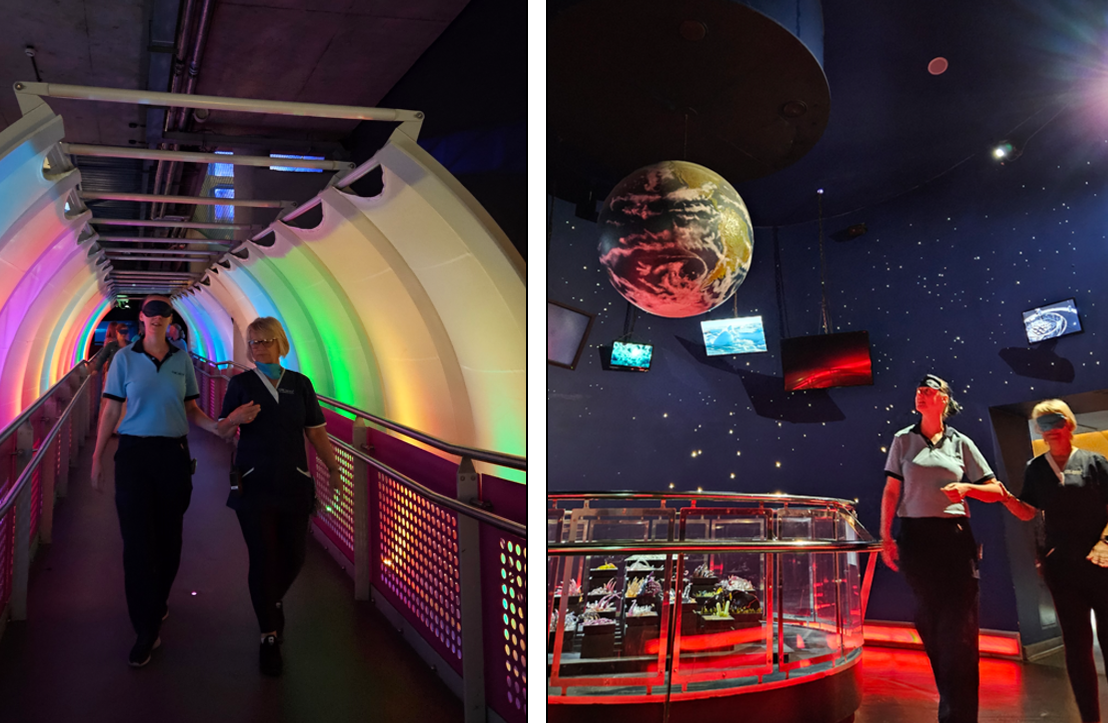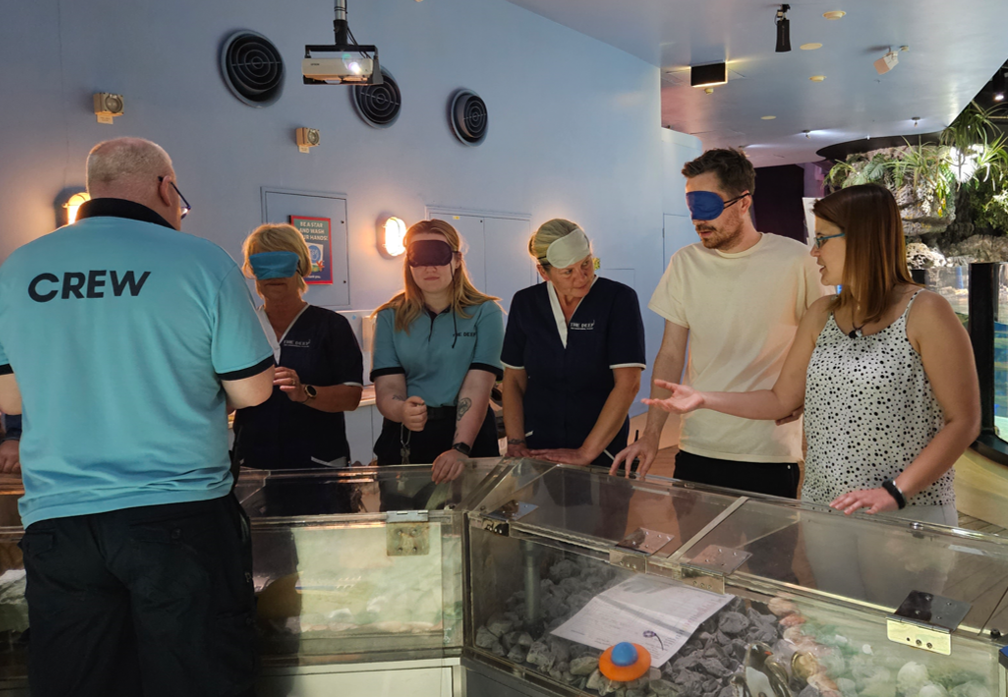Lynsey King, Guide at The Deep, on learning about the blind and partially sighted experience with Guide Dogs UK:
Deep is a visual place for all of our guests and crew alike. We have a number of different exhibits around the aquarium that are home to many animals, from sharks and penguins to frogs and bugs – and, obviously, lots and lots of fish! Our guests explore the building, where they are transported to many interesting aquatic habitats from around the world, from our native shores to tropical coral reefs.
As a Zoology graduate I have always enjoyed being around different animals and, as a Guide, I get to spend lots of time with them, observing their behaviours and educating our visitors about them on a daily basis. It is part of my role here to interpret the displays and create a memorable and inspiring experience for our audiences. As part of The Deep’s education goals our exhibits are also supported by a series of information panels and graphics. This helps our guests to dive deeper into the world of these animals, along with the engagement opportunities provided by our Guides.
Some might consider an aquarium a living art gallery, providing visitors the opportunity to see aquatic animals that they may never come across. How can we ensure individuals with sight loss receive an enriching and enjoyable experience whilst with us? Step in…Guide Dogs UK. This organisation had kindly offered to provide us with the opportunity to receive training to become a ‘Sighted Guide,’ helping to assist individuals with sight loss around the attraction.
A Collaborative Approach.
The Sighted Guide Training delivered by Kelle from Guide Dogs UK, was insightful and worthwhile. The tools provided to us to help guide a person who is blind or partially sighted were effective in practice and could be applied to all situations, regardless of whether we are at work or when out in society. Whilst our Guides are only trying to facilitate an experience, it can mean encroaching on the guest’s personal space and taking away their freedom to react in whichever way they wish to during engagements, such as artefact handling. Therefore, the tools given to us during this session were especially designed to allow the Guide to provide independence to the person that they are supporting. This individual is being empowered to get involved with experiences that may have been inaccessible or uncomfortable for them without the assistance of a ‘Sighted Guide.’
Where Do We Start?
Firstly, we were introduced to the facts and figures behind sight loss, and how many people develop and live with sight loss within the UK - it was definitely many more than I expected! During this exercise we explored the challenges that are associated with sight loss, which could span from social isolation to financial concerns stemming from unemployment. By being mindful of these concerns Kelle was able to encourage a deeper empathy for individuals with sight loss and helped us to identify and provide for their needs with confidence. This theory session was then followed by a practical session, this involved the use of a blindfold and some stairs!
Me putting my training into practice by guiding another member of the crew and being guided myself using the learned techniques.
The Guiding Arm
To support an individual effectively we were encouraged to use the ‘Guiding Arm.’ The crew member wearing the blindfold is holding their Guide’s arm just above the elbow in a C-like grip. When the Guide moves in a particular direction, the person being guided can feel which direction their Guide is moving in and will instinctively follow. As I led my colleague through the exhibition during the practical, I found that this technique significantly reduced the amount of verbal instructions that I needed to issue when moving from one place to another. Without realising it I became almost invisible, giving a great level of support and guidance with minimal effort. This was also beneficial when directing the person to an item, such as railing or an artefact. In this situation the Guide would extend their hand to touch the item that they wish to present to the person that they are guiding. The person can then travel down the arm of the Guide to find this item themselves, without being physically moved. When taught to us this seemed such a simple idea, and made the experience much more fluid and enjoyable. With practice, it is pretty easy to pick up this technique.
Where Am I?
Overall, this exercise was very enlightening as we were put into the shoes of an individual with sight loss. Whilst wearing the blindfold you quickly realise how disorientating and exhausting it is to navigate your way around without effective help. You are very conscious that you may bump into something and potentially injure yourself! This person is therefore heavily reliant on their Guide for support.
I am very familiar with our facility having worked here for 9.5 years, however – when removing the blindfold and having travelled through the building – I still was not in the place where I thought I was. Therefore, for someone with sight loss visiting a place that they are not familiar with, this experience is likely to be very daunting. It may even discourage someone from visiting entirely. Therefore, now having the ability to support an individual with sight loss effectively with confidence has been really empowering. I would recommend to it anyone.
Crew members at The Deep during the practical element of Sighted Guide Training.
All Aboard.
Furthermore, this training was great for crew engagement. Here we were paired up with a colleague for the practical element of the training. We approached this session with an open mind and a sense of humour, meaning that we all had quite a good laugh throughout.
I would very much recommend this training to anyone. I like to think that I am an empathic person anyway – which is one of the reasons why I have been a Guide for as long as I have – but this has really been worthwhile by seeing things from another perspective. This for me was the best part of this experience. I can now provide the opportunity for someone who is blind or partially sighted to further engage with our exhibits and help provide a memorable and supportive experience. Before this training I didn’t realise just how far-reaching and diverse sight loss is. It is a spectrum, where one size doesn’t fit all. I now look forward to putting my new skills into practice.
For more details on becoming a ‘Sighted Guide’ you can visit the Guide Dogs UK website at https://www.guidedogs.org.uk/how-you-can-help/sighted-guide-training.
Lynsey King, Guide, The Deep.
All blogs reflect the views of their author and are not a reflection of BIAZA's positions.
Related Members
-
News
 Belfast Zoo helps to bring Christmas joy to Children’s Hospital 19th December, 2025Belfast Zoo joined the Lord Mayor of Belfast, Councillor Tracy Kelly, on Monday (15th December) to help bring festive cheer to the Royal Belfast Hospital…
Belfast Zoo helps to bring Christmas joy to Children’s Hospital 19th December, 2025Belfast Zoo joined the Lord Mayor of Belfast, Councillor Tracy Kelly, on Monday (15th December) to help bring festive cheer to the Royal Belfast Hospital… -
News
 Colchester Zoological Society welcomes new arrivals 19th December, 2025This December, Colchester Zoological Society (CZS) welcomed some exciting new arrivals! A young male pygmy hippo, Mikolas, from Zoo Dvur Kralove…
Colchester Zoological Society welcomes new arrivals 19th December, 2025This December, Colchester Zoological Society (CZS) welcomed some exciting new arrivals! A young male pygmy hippo, Mikolas, from Zoo Dvur Kralove… -
News
.png?w=100&h=100&zc=1&f=jpeg&hash=8d175f93cde920c5ba23c8ea7f92e55a) Blog: Understanding the human side of zoos 16th December, 2025Why are zoo researchers increasingly looking to social science? Dr Nieky van Veggel explains the significance of understanding the human dimension…
Blog: Understanding the human side of zoos 16th December, 2025Why are zoo researchers increasingly looking to social science? Dr Nieky van Veggel explains the significance of understanding the human dimension…




